This is part two of Gowanus Houses and Wyckoff Gardens: Neighborhood Anchors, my final paper for the class Urban Political Processes.
The History
 |
221 Hoyt Street June 27, 1945, shortly before
being demolished to make way for the
Gowanus Houses
Photo courtesy of NYCHA |
The Gowanus Houses came first. Bordered by Wyckoff, Douglass, Bond and Hoyt Streets, the 12.57-acre complex was completed June 24, 1949. With 1,134 apartments spread across 14 buildings that vary from 4, 6, 9, 13 and 14-stories high, it houses an estimated 2,836 residents. To make room for the site, NYCHA began demolishing 199 buildings there on September 3, 1946, resulting in the eviction of 442 residential tenants and 62 commercial tenants.
Befitting its name, the development straddles the neighborhoods of Boerum Hill in the north and Gowanus in the South. It was designed by Rosario Candela, Eli Jacques and William T. McCarthy, and estimated to cost $6,738,000 when it was proposed in 1945. McCarthy, the chairman of the board of the housing for the Brooklyn Bureau of Charities, was also instrumental in the design of the Red Hook Houses, which were finished in 1938, just a year after the passage of the United States Housing Act of 1937.
Perhaps stung by criticism from Lewis Mumford, who in a 1940 New Yorker column Versailles for the Millions criticized Red Hook as “Leningrad formalism,” “barracklike” and “hygienically undesirable,” he laid the Gowanus Houses out in a more varied pattern, with
five different building heights.
 |
| The announcement of the Gowanus Houses |
Wyckoff Gardens, which is just one block west, between Third Avenue, Nevins, Wyckoff and Baltic Streets, came 17 years later, on December 31, 1966. It consists of three 21-story buildings on 5.81 acres, with 528 apartments housing some 1,226 people. Like the Gowanus Houses, it is linked to the industrial Gowanus neighborhood; the pumping station for the Gowanus Canal is a mere block and a half away on Butler Street.
Although it is newer than the Gowanus Houses and much more compact, Wyckoff Gardens, which is named after Pieter Claesen Wyckoff, a 17th-century immigrant from the Netherlands, is very much tied to the Gowanus Houses; when it was first proposed, it was known as Gowanus Area Federally Aided project No. NY-5-74.
When it was first proposed by NYCHA on August 29, 1962, at a cost of $10,234,000, it was estimated that there were 317 tenants living on the site, of which only 206 were deemed eligible for public housing. Planning documents reveal the rationale for placing the development in this particular area:
The condition of the buildings in the neighborhood varies considerably. The dwellings in the conversation district are in fair or good condition as are the houses between Nevins Street and the Gowanus Houses. The conditions of the structures on the site, however, is generally poor. Most of the buildings have deteriorated to the point where clearance is necessary.
(From
Major Change to the Development Program Project No. NY5-74 For 531 Dwellings Program Reservation No. 5-C Gowanus Area, Borough of Brooklyn, NYCHA, August 29, 1962
)
Befitting the hope and promise of the development at the time, one of the first residents of Wyckoff Gardens, Sergeant Leonard Pavia, a World War II veteran, was a guest of honor at “Public Housing Day,” a ceremony held on at City Hall Saturday, Dec. 3. Pavia, who had been paying $110 a month for a five room apartment for his wife and three children, was now paying only $84 a month for the same space.
Design Differences
The two complexes share a goal, as they are both owned and operated by NYCHA, whose aim is
“to provide decent and affordable housing in a safe and secure living environment for low- and moderate-income residents throughout the five boroughs.”
As noted earlier, they are very different designs though. This is not an accident, as the New York City Housing Agency (NYCHA) experimented with different kinds of layouts and designs between 1935 and 1967, the years it was actively constructing public housing. For instance, to construct the appropriately named “First Houses,” on the Lower East Side, in 1935, NYCHA took a series of 1846 tenements and demolished every third building to provide adequate light and air, and rehabilitated or rebuilt the remaining buildings.
Later developments would embrace features such as geometric designs and cross-streets that were closed to create “super-blocks.” Whereas the early 1940’s saw the embrace of the “Tower in the Park” idea, which featured high-rise buildings surrounded by park-like surroundings, the 1950’s were a time when developments were characterized by
in-line layouts and random spacing.
The Gowanus Houses, being the older of the two developments, show elements of the Tower in the Park design, as the eight tallest of its buildings were build for the most part toward the middle of the two super blocks that are split down the middle by Baltic Street.
The Wyckoff Gardens are an even more extreme variation of the Tower in the Park model, as its three 21-story buildings are surrounded by even more greenery. Since their nearest neighbors top out at no more than 5 stories, the Wyckoff Gardens’ upward thrust appears even more dramatic than the tallest Gowanus House buildings, which at 14 stories are not short by any stretch either.
 |
Architectural renderings submitted by McCarthy’s firm to NYCHA.
Courtesy of the Brooklyn Historical Society |
In addition to the height differences and setbacks, the developments most obviously differ in color. While the Gowanus Houses were build with traditional brick, and thus more closely match many of the original structures in the neighborhood, the Wyckoff Gardens sport a white finish, which, while completely out of place, at least has the effect of giving the buildings’ an appearance of being lighter than they really are.
One would never mistake them for a condominium in Miami, Florida, but at the same time, they’re less imposing than the Gowanus House buildings which, outfitted with massive water tanks atop them, appear to be hunkering down with hunched shoulders. This difference in appearance can be attributed to the push of architects working for NYCHA who were tired of the agencies’ seeming indifference to creativity.
The architect Albert Mayer, in a series of tough radio conversations with NYCHA administrator Ira Robbins in 1962, asserted that that authorities obsession with low ground coverage inhibited the creations of better architecture. Robbins responded defensively, but he grudgingly agreed that he would be happy to look at Mayer’s estimates. In a different public appearance, Robbins sounded like the old guard when he defended the use of “Hudson River red” brick because anything else was very much more expensive. I’m not alone in my assessment either:
In the distance, the Deco crown of the Williamsburgh Savings Bank Tower, the tallest building in Brooklyn, once its only legitimate high rise, and until recently, a haven for dentists’ offices, though now inevitably converted into condos, towers over the Wyckoff Gardens, a public housing complex whose white-brick facades make it appear more hopeful or at least less stigmatized than the usual grim red project brick of the Gowanus Houses, glowering off to the right.
 |
| The Wyckoff Gardens, as seen from the south, in Gowanus |
Next: Crime and the developments' relation to the community....
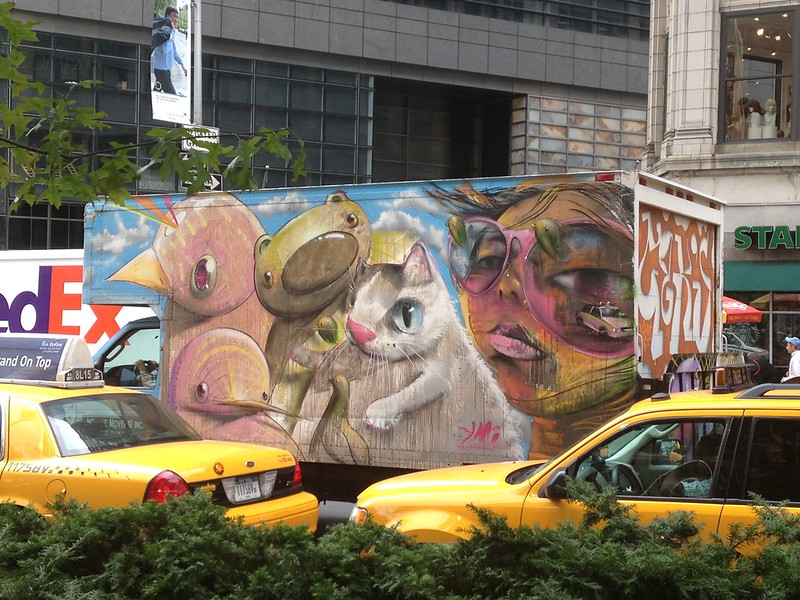

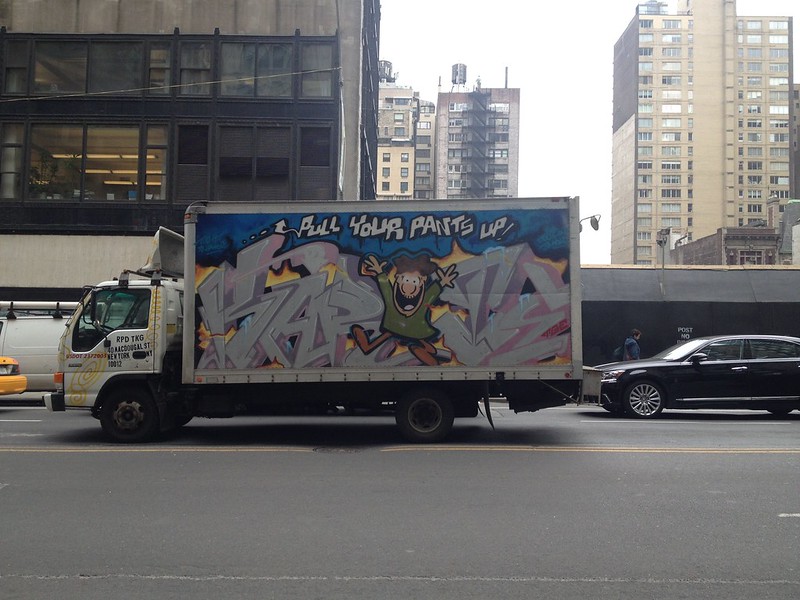

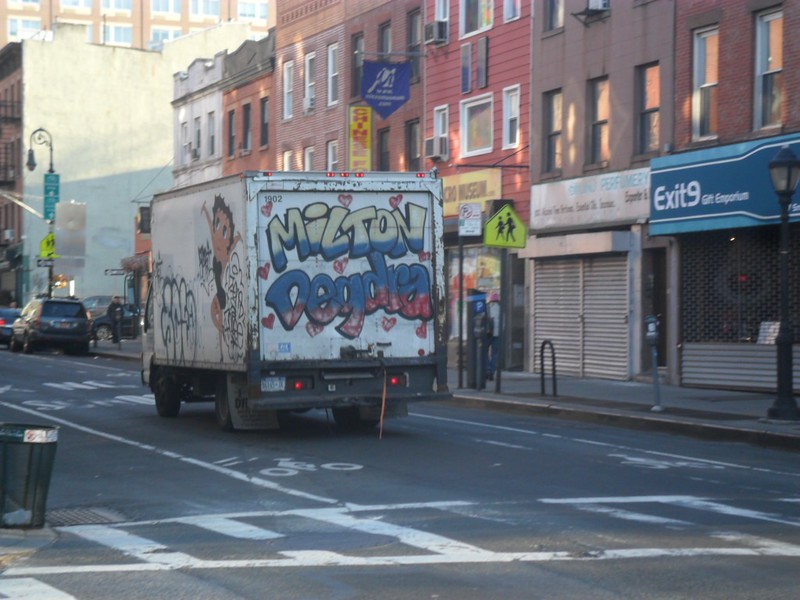
 Eh....
Eh.... Did we not finish this one? Note the reference to Instagram....
Did we not finish this one? Note the reference to Instagram.... But when they're done right, trucks with murals are like the perfect amalgamation of motion, pizzazz, and whimsy. This van, which was done by the Smart Crew, was parked in the shadow of the Navy Yard.
But when they're done right, trucks with murals are like the perfect amalgamation of motion, pizzazz, and whimsy. This van, which was done by the Smart Crew, was parked in the shadow of the Navy Yard.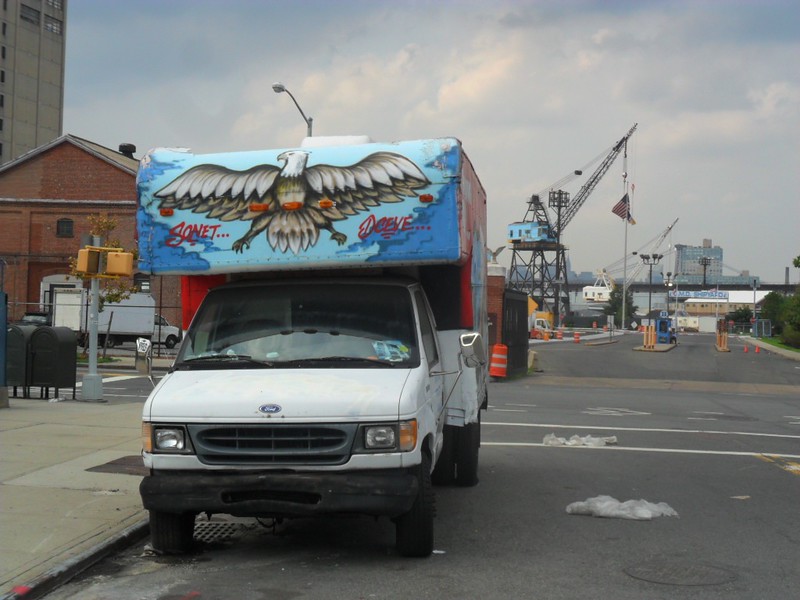
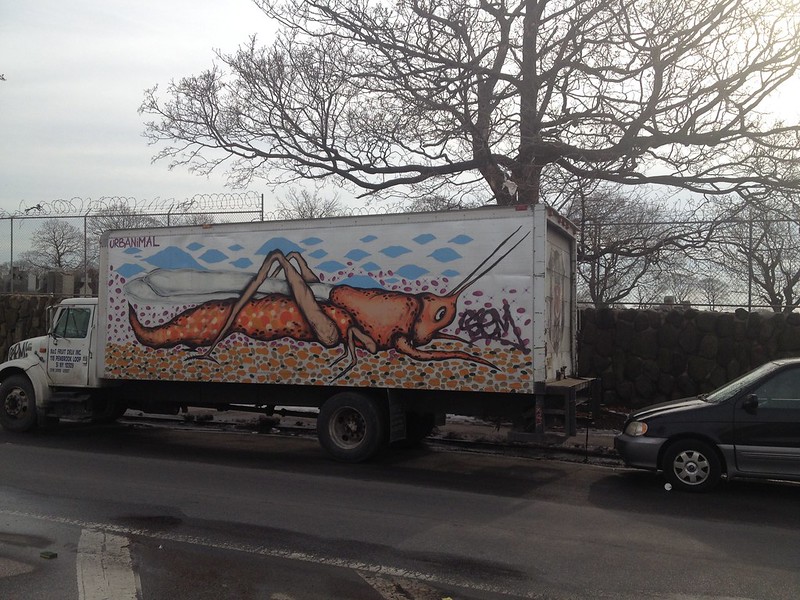 Grasshopper, from Urban Animal, on Queens Boulevard.
Grasshopper, from Urban Animal, on Queens Boulevard.
 Spotted this truck on Fordham Road.
Spotted this truck on Fordham Road.


































